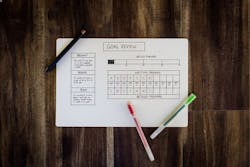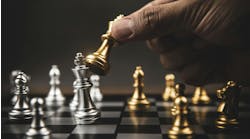Many of you know that I am a student of lean practices. For the last 15 years or so, I have been given the wonderful opportunity to design and implement lean systems for the body shop environment. One of the main building blocks of lean revolves around the idea of continuous improvement and constant evolution so that the business grows, and so do the stakeholders in the business.
In order to gauge the amount of value we derive from improvement models and their implementation, I have learned to go beyond the quick-check model of setting a goal and then sometime in the future assessing if the goal was met or not. Goal setting is important, of this there can be no doubt. But a habit of reflecting on my intentions, what I did about them, the results, and what I learned along the way is a great supplement to the goal setting process. Lean practitioners use the Japanese word for this concept of self- reflection: hansei.
Hansei as a concept is hard to translate. If you break down the words, “han” can mean turn over, or turn upside down and “sei” can mean reflect on or examine oneself. In Japanese culture, it can mean acknowledging one’s own mistakes and pledging improvement. In the world of lean, hansei is a continuous but subtle form of meditation and self-reflection focusing on past mistakes, outlining plans to correct the mistakes, and promising oneself to act on those plans.
Before you think of me as some sort of dude that sits around cross-legged in a lotus yoga pose chanting “Om” every chance I get—forget about it. I leave the yoga stuff to my wife.
I do make a habit of practicing hansei about every six months. My method is to walk, think, write down some notes, and then make course corrections to my intentions as needed. Often the current reality is far different than the expectations that were set six months prior.
The last year and half for me has been a challenge primarily because the context of daily life has been so unrelentingly abnormal. Practicing hansei has been a struggle but I suppose it is such an ingrained habit for me that I kept it up. This contrasts with a few other good habits that I let slip during the last 18 months, habits I seriously need to rebuild.
The thing is, those good old habits and routines are not going to look the same as they did in early 2020. For many people, the rebuilding of exercise routines, healthy eating regimens, and other good habits will be difficult because they were dropped for so long. It is not like bouncing back from dropping good habits over the Thanksgiving and Christmas holidays. With that in mind, I recently chose to decrease the time between my hansei sessions and now am doing them on a monthly basis instead of every six months. I hope to gradually revert to a semiannual routine, but right now there is tremendous benefit in making course corrections more rapidly in the current environment.
In business, hansei is a critical part of becoming a learning organization. Hansei is a vital element of kaizen (continuous improvement) and of creating a culture of curiosity. Here the emphasis is on what went wrong and what must be done to make sure it does not reoccur. It is a touchy process to implement because if it is handled incorrectly employees are going to feel personally attacked when flaws are pointed out. If the employee feels the focus is on “who” went wrong instead of “what” went wrong, you are doomed.
Toyota is, of course, one of the preeminent practitioners of lean. Hansei is inculcated into the entire organization but is still a hard concept to understand. One of their American program managers, Andy Lund, was able to explain the concept this way:
“People who have not been to Japan may not understand that the objective is not to hurt that individual but to help that individual improve—not to hurt the program but to show flaws to improve the next program. If you understand that deeply, you can get through that constructive criticism. No matter how good a program or a presentation someone makes, we believe there is always something that can be improved, so we feel it is our obligation. It is not an ‘obligatory negative’ but an obligatory opportunity to improve—it is the heart of kaizen.”
If you decide to explore the idea of introducing hansei in your business, I recommend that you start with yourself. There are several levels of hansei that range from rapid and brief reflections on decisions made, tasks completed, lessons learned, to direct and honest reviews of performance and results, all the way up to the meditative self-reflection and introspection that I describe earlier. Once you begin the practice of hansei in your personal life, it will become so much easier to introduce it in your professional life.





